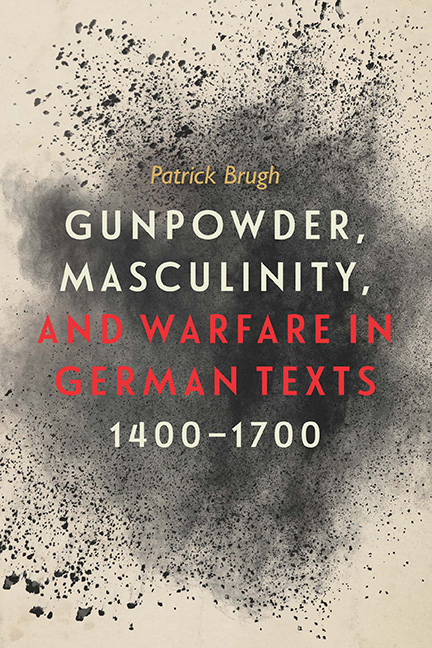Book contents
- Frontmatter
- Dedication
- Contents
- List of Illustrations
- Acknowledgments
- A Note on Translation and Spelling
- Abbreviations
- 1 A Tale of Two Suits of Armor
- 2 Of Hussites and Haystacks, of Questions and Cannons
- 3 Textbook War: The Genealogy of Kriegsbücher
- 4 Gunpowder Dilemmas and Loaded Peace in Fronsperger's Kriegsbuch
- 5 Depicting Gunpowder in German Military Broadsheets (1630–32)
- 6 Gustav Adolf's Gunpowder Demise
- 7 The Aesthetics of Gunpowder in Seventeenth-Century German War Novels
- 8 Cavalier Endings in Happel's Der insulanische Mandorell (1682)
- Appendix: Comparisons of Broadsheets from Battles of Breitenfeld, Rain am Lech, and Lützen
- Notes
- Bibliography
- Index
5 - Depicting Gunpowder in German Military Broadsheets (1630–32)
Published online by Cambridge University Press: 25 March 2020
- Frontmatter
- Dedication
- Contents
- List of Illustrations
- Acknowledgments
- A Note on Translation and Spelling
- Abbreviations
- 1 A Tale of Two Suits of Armor
- 2 Of Hussites and Haystacks, of Questions and Cannons
- 3 Textbook War: The Genealogy of Kriegsbücher
- 4 Gunpowder Dilemmas and Loaded Peace in Fronsperger's Kriegsbuch
- 5 Depicting Gunpowder in German Military Broadsheets (1630–32)
- 6 Gustav Adolf's Gunpowder Demise
- 7 The Aesthetics of Gunpowder in Seventeenth-Century German War Novels
- 8 Cavalier Endings in Happel's Der insulanische Mandorell (1682)
- Appendix: Comparisons of Broadsheets from Battles of Breitenfeld, Rain am Lech, and Lützen
- Notes
- Bibliography
- Index
Summary
Twenty-seven small and large artillery pieces were planted in a crosswise fashion against Tilly's army, among which the pieces on the right-hand side were loaded with shrapnel shot, but the pieces on the left-hand side were loaded blind so that they gave off a thick smoke.
—A Description of the Battle of the River LechHe said: I know just the thing to cure this wicked ailment,
Pointing to the kegs and balls with a finger movement,
Herein lies my cure: I'll stick in a couple pills,
And mix up quite a potion of cannons big and little.
—“The King of Sweden's and Elector of Saxony's Apothecary”Technically speaking, black powder does not explode. It deflagrates. While detonation results in a supersonic wave, deflagration creates a subsonic one. The powder, made from charcoal, sulfur, and saltpeter, burns upon ignition, propagating a spray of molten salts between its grains, and releasing gas in the form of smoke. Packed behind a cannon or musket ball, deflagrating black powder fills the barrel chamber with gas and propels the shot out of the gun at a high velocity. As the shot exits the firearm, the built-up smoke puffs from the mouth of the barrel.
Early modern writers and artists, interested in narrating and illustrating war stories for distribution to an increasingly news-hungry public, needed to transform these instantaneous technical and chemical processes into written descriptions and static visual images. As a news medium that reported on battles and military engagements during the early modern period, the military broadsheet combined text and image for the edification of the public. In the process, the broadsheet (Flugblatt) medium needed to respond to the complex visual and narrative features of gunpowder warfare to make news reports of battle comprehensible to a broad readership. Each of these forms of representation—text and image—had limitations and advantages, as well as conventions, for describing gunpowder warfare. This chapter examines gunpowder as a represented physical object, a narrative tool, and a metonymic symbol in military broadsheets during Gustav Adolf's campaign in German lands between 1630 and 1632.
- Type
- Chapter
- Information
- Publisher: Boydell & BrewerPrint publication year: 2019

